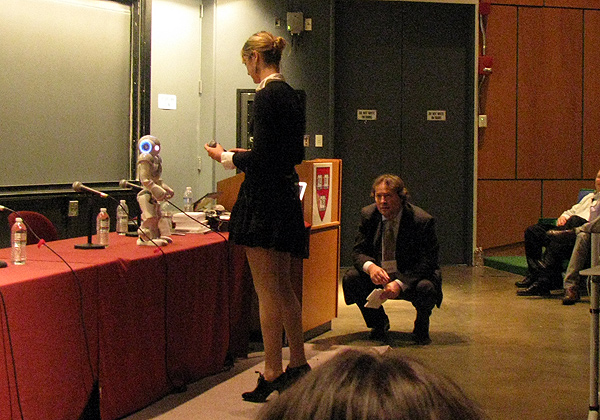[Continuing coverage of the 2010
H+ Summit at Harvard.]
Heather Knight (bio) had the first presentation after lunch. She’s a young computer scientist, fresh out of M.I.T. undergrad, and she is interested in (even an evangelist for) socialized robotics. She goes through some of the standard stuff about making robots that can sense and imitate human emotions, and then starts in with attempting to contrive reasons for doing this, such as amusing kids who are waiting for their parents to pick them up. (A teddy bear won’t suffice?) This echoes a chain of dialogue about socialized robotics going back at least to the 1960s and Joseph Weizenbaum’s ELIZA, a simple text-based program that tricked people into thinking it could converse with them, and that many people seriously suggested be used as a psychological therapist.
Knight’s presentation is low on content; even for socialized robotics, a field aimed at tricking people into believing there is complex behavior where there is not, the robotics presentation she puts on is very elementary — a prefabricated robot with minimal voice-recognition capability, which summarizes
Star Wars, complete with sound effects. The audience eats it up, though. This is clearly a presentation in many different ways aimed at style over substance. At least
one Twitterer was a fan of the show, though, and
another aptly noted, “I think Heather Knight thinks her performing robot is a real boy.”
Knight has the same problem as every other social roboticist, which is the blithe belief that she can recreate through pure engineering a “system” (i.e., human interaction) that is as complex as anything we know — and, moreover, can recreate it from whole cloth, without any apparent engagement with or even awareness of the wealth of thought about social life. For more about this, see our
New Atlantis colleague Caitrin Nicol’s
wonderful essay about the follies of social robotics.
I don’t mean to pick on Heather Knight. Like most other presenters, Knight is just presenting her research here, not purporting to present some grand unified theory; but few of them seem to realize the intellectual burdens that making these sorts of claims must bear. She certainly has a stage presence, though, and it’s striking that her talk just reflects the trend of almost every presentation here so far having either been on an obscure and relatively unimportant technical subject, or else a repetition of stock transhumanist ideas. There’s been almost nothing new here. I’m not sure whether to blame the presenters or the organizers, but hopefully it’ll pick up as the conference goes on.



You bring up some interesting points, but I think this story misses the point. Social robotics is not about replacing humanity, as this article suggests. Social robotics is about making technology that humans will respond to in better, more thoughtful ways.
Though you may be disappointed overall with the lectures in general, you should still uphold journalistic standards when writing about it. Ms. Knight is not "fresh out of M.I.T. undergrad". She has two masters degrees from MIT and is pursing a doctorate at Carnegie Mellon University in the fall. That she is young and female in a very predominantly male field, is very impressive.
Thanks for your comment, C&BD. You are right to say that social robotics is about altering how we human beings relate to our machines — or, as some might put it, duping people into treating machines as though they were alive — but you have really only raised a new question. What do you mean when you say that humans will respond to their machines in "better" and "more thoughtful" ways?
Meanwhile, thank you for letting us know about Ms. Knight's graduate studies; I've just corrected the post above. Apologies for the error. (In our defense, neither her bio sketch on the conference website nor her homepage autobiographical blurb explicitly mentions a master's degree; we mistakenly understood them as suggesting that she earned multiple undergraduate degrees from M.I.T. However, a bit of googling confirms that you're correct. Thanks again.)
My talk was a playful call to use robot theater in the development of charismatic technologies! You can check out the slide-deck here: http://www.slideshare.net/humanityplus/knight-4671470 — I don't recall the amusing children while parents are waiting to pick them up example, but I do remember talking about the importance of interface design on higher level technological feats like traveling to mars, remote-communication and the established value of technology in autism therapy. I want to empower people not replace them! As Cynthia Breazeal recently said, I think people are pretty savvy, they know the difference between robots and people. And as much as my mother is excited to have my little robot in the family, she says I'm not off the hook for a real grandchild (uh-oh!)! Stay tuned for future performances!! My TED video should be posted soon as well, and as always, thanks for your feedback!
Thanks for your comment, Ms. Knight. I certainly think there is a place for robotics in our society, even cute and amusing robots. But you might want to take a look at the professed philosophy of prominent social roboticists, whose intentions are hardly so noble as you state yours to be. Most of them take humans to already be robots of a sort, possessing of minds and internal lives that are so simple they will be replicated without much effort — and that, in the meantime, are not deserving of much more respect than you would give an equivalently sophisticated computer. (Take, for example, the paradoxical formulation of Rodney Brooks: “We, all of us, overanthropomorphize humans, who are after all mere machines.”) I strongly recommend the essay by Caitrin Nicol mentioned in this post exploring the philosophy of social roboticists.
On a more general note, I would gently suggest that you take a closer look at the ideas being pushed by the other presenters and attendees at conferences like the one you spoke at. While social roboticists at their worst usually just want to trivialize human beings, transhumanists by definition have taken the next logical step and avowedly want to see humans done away with. ("Replaced" is the nice way of putting it, evoking as it does a burned-out light bulb.) The association between these two ideas, as I have suggested, is not happenstance. And while every conference has its spectrum of ideological disagreement among its attendees and presenters, the question of whether human beings should continue to exist is not such a small one.